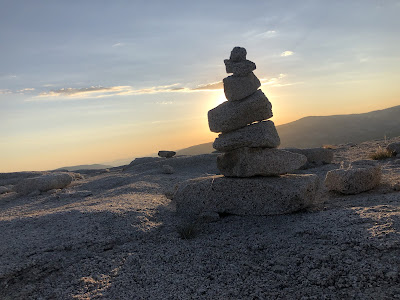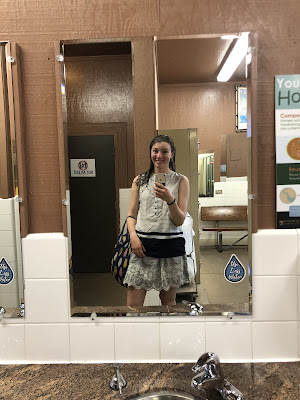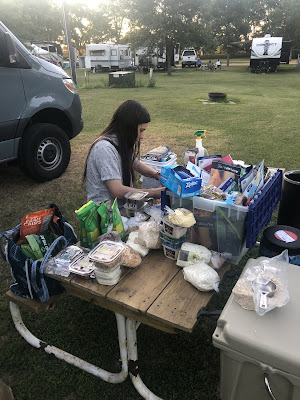Due to a series of unrelated events culminating in a 21-day hike in California, we had a long distance to cover in a short amount of time. Correction: Cameron had a long distance to cover in a short amount of time. He drove from Chicago, IL to Las Cruces, NM in five days all by himself, including a 1.5 day layover in Lexington, KY. We’ve both, at various time, had to take the van on small solo drives, but never more than a half day of running errands. Cameron came across some unexpected differences on his 1900-mile solo trip:
- Multitasking is not an option. If you need to grab something from the back of the van, are trying to eat a quick meal, or look at what viable stops are nearby requires a pull-over to the side of the road. You are at the mercy of the roads before you can find a place to stop and figure things out.
- No copilot means more chores. Dinner decisions, cooking, dish washing, changing the litter box, etc.
- It’s more scary to push your limits as far as overnight stops. Cameron mostly stayed at iOverlander-approved rest stops, but for the last night ended up at an abandoned burnt-out gas station in the middle of nowhere along the border of Texas and New Mexico. He said it was cool, but a little unnerving.
- The rabbit is a better companion and a good excuse to pull over and take a rest from driving for 20-30 minutes.
- With just one person, the gray tank doesn’t fill as quickly so there are fewer mental calculations needed to take an in-van shower.
Maybe those aren’t the most monumental changes, but I really appreciate that Cameron took that on so that we could continue (together) for an additional 18 hours to Yosemite National Park. That 18-hour drive was our first trip sans-rabbit. There were times that I missed her, but we were so focused on our destination that it was good we didn’t have to worry about her needs. The only real difference is not having to have the AC going when we leave the van.
Curry Village’s backpackers’ parking lot was to become the resting stop for Vanjie for the next 3 weeks. The amount of time isn’t on its own a particularly alarming worry – many people leave their vehicles in the same long-term parking lot – but not being able to monitor the van made us a little concerned. For one, bears are a major nuisance in that part of Yosemite. If there is any food views or scents emanating from your vehicle, it is possible that you’ll return to a ripped off door. We hadn’t planned well ahead of time, so while some of our pantry good fit inside a bear-safe cooler, the rest was packed into a standard-but-flimsy plastic organizing box.
There were a few things we needed to transfer to the refrigerator because we thought the smells might be too pungent (such as my fancy beet and black pepper drinking vinegar). We had already planned to keep the fridge turned on; Cameron had calculated that there should be plenty of battery, supplemented by ongoing solar power, to keep it running. We disconnected the car entertainment system from the battery and disconnected the routers. Nothing else needed ongoing power, but I still was worried that somehow we’d drain the car’s battery, like had happened in our early days of van ownership.
We shut off the water pump and closed off the water manifolds. We also moved all of the stove fuel outside of the van (we didn’t want a heat-related explosion, so we tucked the canisters behind one of the wheels) and we ensured all of our trash was dumped. We neglected to drain the urine tank, which I only realized a few days into our backpacking adventure. Only after returning to the van 3 weeks later, we realized we should have also drained the drinking water.
Once the window covers were up, there was nothing left to do but wait and see how it held up upon our return. Along the hike, I imagined we’d return to big bear scratches, a missing door, or simply no van at all (the park will have vehicles towed if they are inviting bear activity). Even if the van was there, would the inside reek of sewage or would there be some sort of internal explosion? I’m happy to report that the van was in good condition, it did not stink (although it was pretty hot inside), and our stashed fuel cans were still there. The only light concern was that the water tank tasted a little tainted, but we’ll give it a good cleaning relatively soon.
All of the worry was worth having our house and all of our possessions accessible at the end of the trip. To be able to grab fresh clothes (including underwear!) and grab a cold drink after a 260-mile hike was amazing! Also having a place to dump our heavy backpacks while we explored Yosemite Valley was unexpectedly delightful. This is not the first time where I’ve been happy that my vehicle has all of my possessions after a trip, but this was definitely the most benefit we’ve gotten from that reality.

And then almost 3 weeks later – the sunset from the top of Half Dome.
Having my full wardrobe accessible was so nice. I went from this (grimy sweaty clothes that hadn't been properly washed in weeks)...
...to this! You might not see a difference but I felt a huge improvement!
Post-backpacking van life is great, but backpacking prep van life is less than ideal. I'm used to having a large dining room table and living room floor to use for food prep. We had to make do with various campground picnic tables.
Instead of an indoor laundry rack, I used this tree to hold our clothes while I sprayed them with pre-trip bug protection.









No comments:
Post a Comment